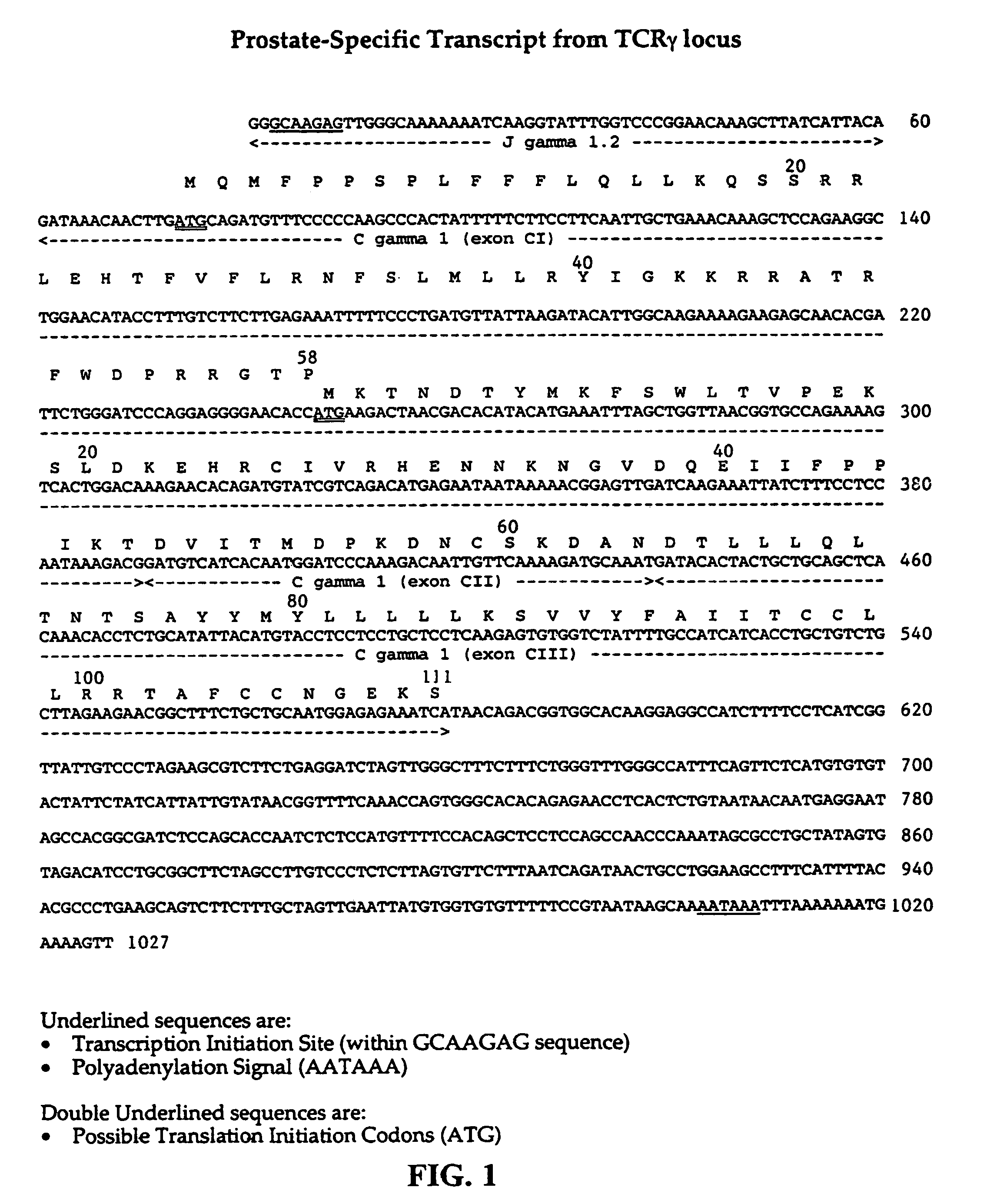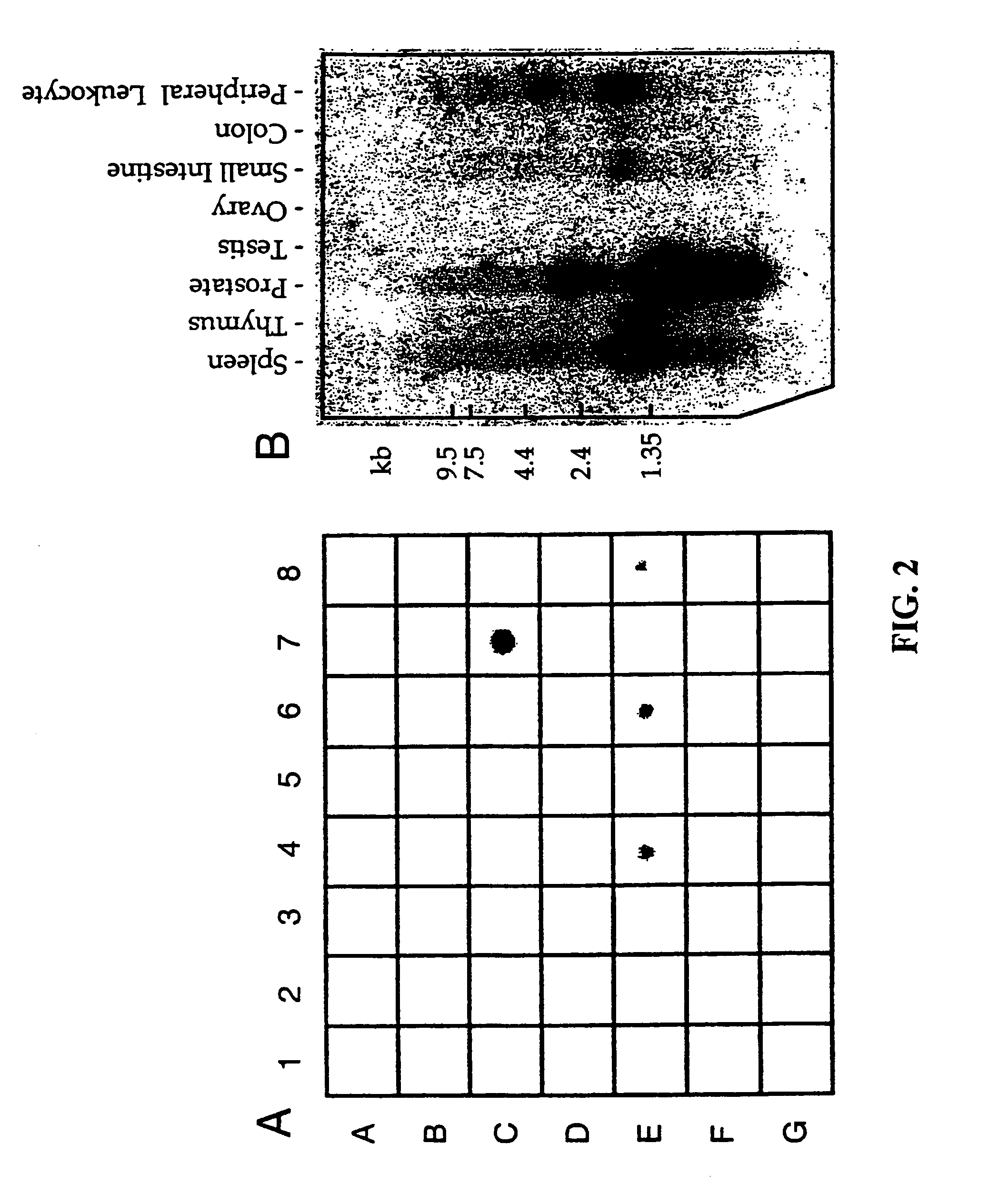T-cell receptorγ alternate reading frame protein, (TARP) and uses thereof
a technology of t-cell receptor and reading frame, which is applied in the field of molecular biology and medical diagnostics and therapeutics, can solve the problems of determinants no longer escaping detection by the immune system, and destroying both cancerous cells and healthy cells
- Summary
- Abstract
- Description
- Claims
- Application Information
AI Technical Summary
Benefits of technology
Problems solved by technology
Method used
Image
Examples
example 1
Detection of T-Cell Receptor γ-Chain in Prostate Cells
[0200]We identified expression of T-cell receptor γ-chain (TCRγδ mRNA in human prostate and showed that it originates from epithelial cells of the prostate and not from infiltrating T-lymphocytes. In contrast, the T-cell receptor δ-chain (TCRγδ gene is silent in human prostate. The major TCRγ transcript in prostate has a different size than the transcript expressed in thymus, spleen and blood leukocytes. It is expressed in normal prostate epithelium, adenocarcinoma of the prostate and the prostatic adenocarcinoma cell line LNCaP. The RNA originates from an unrearranged TCRγ locus and it is initiated within the intronic sequence directly upstream of the Jγ1.2 gene segment. The prostate-specific TCRγ transcript consists of the Jγ1.2 and Cγ1 gene segments, it has untranslated sequence including a polyadenylation signal and poly(A) sequence at the 3′ end. The finding that prostate epithelial cells express a high level of a transcript...
example 2
Discovery of the TCRγ Alternate Reading Frame Protein
[0234]The previous Example demonstrated the unexpected discovery of TCRγ transcript in prostate and prostate cancer cells, the in vitro translation of the transcript, and the initial hypothesis that the transcript resulted in the presence of a truncated form of TCRγ chain in these cells. This Example sets forth the further unexpected discovery that the transcript in fact results in a previously unknown protein, now designated “TARP,” expressed from an alternate reading frame. Even more unexpectedly, the studies reported below show that TARP is a nuclear protein, and is present in many breast cancer cells.
Materials and Methods
[0235]Primers. (SEQ ID NOs.: 19–31) TCRγ-upATGmut#1 (5′-TTACAGATAAACAACTTGATACAGATGTTTCCCCCAAGCCC-3′); TCRγ-upATGm#2 (5′-GGGCTTGGGGGAAACATCTGTATCAAGTTGTTTATCTGTAA-3′); TCRγ-upATGm#3 (5′-GATAAACAACTTGATGCAGATATTTCCCCCAAGCCC-3′); TCRγ-upATGm#4 (5′-GGGCTTGGGGGAAATATCTGCATCAAGTTGTTTATC-3′); TCRγ-upATGm#5 (5′-GATAA...
PUM
| Property | Measurement | Unit |
|---|---|---|
| molecular weight | aaaaa | aaaaa |
| temperature | aaaaa | aaaaa |
| temperature | aaaaa | aaaaa |
Abstract
Description
Claims
Application Information
 Login to View More
Login to View More - R&D
- Intellectual Property
- Life Sciences
- Materials
- Tech Scout
- Unparalleled Data Quality
- Higher Quality Content
- 60% Fewer Hallucinations
Browse by: Latest US Patents, China's latest patents, Technical Efficacy Thesaurus, Application Domain, Technology Topic, Popular Technical Reports.
© 2025 PatSnap. All rights reserved.Legal|Privacy policy|Modern Slavery Act Transparency Statement|Sitemap|About US| Contact US: help@patsnap.com



